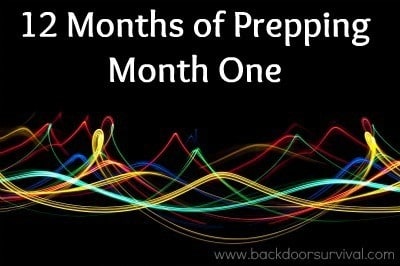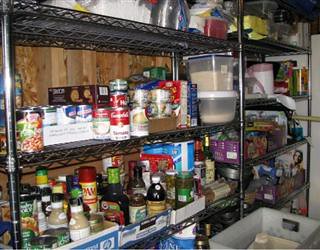For these reasons, a sizable segment of the population has turned to prepping and family preparedness as a solution to the inherent dependence we have on supermarkets, shopping malls, organized medicine and governments. It is not that these entities are going away, not all it all. It is simply that we do not want to have to be dependent.
Instead, we prefer to embrace what is commonly called the “Survival Mindset”.

What is the Survival Mindset?
The survival mindset is a frame of mind whereby daily life is focused on the pursuit of of independence and self-reliance. This focus is done in a non-obtrusive way to the determent of no one and the betterment of everyone. It is a lifestyle and a commitment to preparedness and to courage, to optimism and to family values. Ultimately, it is the will to live and to survive with the knowledge that you have done the very best you can to protect yourself and your family from danger and the woes that come from living in complicated and uncertain times.What I have just described is also the Backdoor Survival mindset. And while I would like to think that it is the very best description out there, I am not arrogant enough to think that what works for me will work for everyone. But – and you know how I like to do this – whether you are an experienced prepper or a newbie that is just beginning to get your toes wet, you need to think about your own personal Survival Mindset and move to a survival place that meets your own needs.
Okay. Enough said abut that. Let us begin with 12 Months of Prepping: Month One.
MONTH 1 SUPPLIES & GEAR:
Let’s talk about water first.
- Water-3 gallons per person and per pet
- Hand-operated can opener and bottle opener
- Canned meat, stew, or pasta meals – 5 per person
- 2 flashlights with batteries
Have you ever woken up in the middle of the night with an unquenchable thirst? That thirst is a signal that your body is dehydrated and is lacking a sufficient quantity of fluids to function. When this occurs, the blood in your body is compromised. More succinctly, it gets completely whacked out. And the result? In addition to increased thirst, dry mouth & throat and chapped lips – all of which are annoying – there is a risk of lethargy, dizziness, decreased urine output, constipation, migraine headaches, wild fluctuations in blood pressure, rapid heartbeat and ultimately, lack of consciousness. Much more, at this point, than a mere annoyance, this can, in fact, be life threatening.
So how bad really is dehydration? Back in 2001 I ended up being carted to the hospital by the local EMTs as a resulted of dehydration caused by food poisoning. Shelly, who is known as the Survival Husband, thought he was losing me; it was not a pleasant experience.
So yes, think about water storage now and make it your number one priority.
There are lot of ways to store water. You can purchase a 55-Gallon Barrel, you can stock up on bottled water, or, if money is tight and you are willing to do a little work, you can clean and fill some empty soda bottles with water from your tap and store them someplace cool and protected for up to six months. I have written an article on do-it-yourself water storage which you can go back to if you need some guidance with your water storage: Survival Basics: Water.
The next items on the list are related: canned goods and a manual can opener. The goal here is to put away some food items that you enjoy, that require minimal cooking, are tasty and – here is the rub – are calorie dense. This is not the time to worry about the very best in low fat, diet-friendly foods. What you are looking at are foods that are going to feed your body with energy.
Have you ever analyzed the contents of M.R.E.’s? (If you are not familiar with that term, M.R.E. stands for “Meal ready to eat” such as the precooked and prepackaged meals used by military personnel in combat.) Many such meals seem tiny in quantity by today’s standards and yet the total calorie count, per meal, is up to 1,200 calories or more.
The moral of this lesson is that in a crisis or emergency situation, your body needs fuel and fuel means calories. As you are planning your canned food storage items, think calories and lots of them.

Raid the pantry to find canned foods that can be moved to emergency storage
One of the easiest ways for a beginner to tackle their initial food
storage needs is to open up their cupboard or pantry and raid the
contents. And for the more experienced prepper? You are still going to
want to take a peek in your cupboards and take a look at the foods you
are currently eating and hopefully enjoying. Have you included these
with your existing supplies? What better time than now than to go take a
look. Pick and choose some new items and add them to what you already
have.Here are some of the canned and prepared food items that I personally have stored away in my survival pantry:
- Canned chicken
- Canned beef
- Canned Soups
- Canned beans
- Canned chili
- Mac and Cheese
- Peanut Butter
- Pilot Crackers in a tin
In addition to food, we have flashlights and batteries on our list of Month One supplies and gear. This is one area where you are going to want to do a bit better than your 99 cent flashlight from the Dollar Store. Not that I don’t love those little LEDs that cost just a few bucks each but in a power outage, you are going to need something a bit more powerful. I like the Eveready lantern-style flashlights that can be modified so that they last a full 2000 hours. I also own a number of Maglites
And then there are batteries – lots of batteries. It is all well and good that you are a good steward of our planet and use rechargeable batteries but trust me, in a power out, grid down situation, you will be thankful that you have a healthy supply of standard alkalines as well.
MONTH 1 TASKS:
The first task in Month One is to inventory your existing supplies, especially any outdoor or camping gear that you may already own. What I did when I first got started prepping is walk around the house, yard and garage, taking note of items I had on hand that could be used if the power were out, if a natural disaster or storm shut down the roadways, or if there was some other crisis.
- Inventory the disaster supplies you already have on hand, including your camping gear
- If you fill your own water containers, mark them with the date they were filled
- Date cans of food and food containers if you have not already done so
Here is a list of some of the things you can look for as you undertake a walk-around inventory. This is not a comprehensive list, just some ideas to get you started.
- First aid supplies
- Warm blankets
- Outdoor cooking facilities
- Cooking fuel
- Knives, hatchets and saws (for cutting away brush)
- Hiking boots
- Self-powered radio gear
- Sleeping bags & tents
- Lanterns
- Firearms and self defense items
Note: Next month we will talk about assessing specific risks so you can better plan for mitigating the consequences of those risks. For now, however,the important thing is to simply take stock of what you already own.
The final task for Month One is to get out those Sharpie’s
I feel you are much better served by focusing on an effective rotation system – first in first out – using the approximate purchase date as a rough guideline. Couple that with rotating food and water twice a year when you change the clocks for daylight savings time and you should be all set.
The Final Word
The very first month in implementing a preparedness plan does not have to be difficult, nor does it have to be time consuming or unnecessarily expensive. Please, whatever you do, do not get frustrated. There is a lot of support in the online community, including the kind folks that visit this website. Ask a question and surely someone will reach out to help with an answer; if not here then on Facebook or one of the other social media platforms.And what if you are a more experience prepper? What better time than now to go back and review your progress and perhaps share your experience with an unenlightened family member or a favorite friend. Send them a copy of this article and help them formulate their own survival mindset and preparedness plan.
Be patient and gentle with them if they don’t at first understand. In the long run, they will thank you.
Please share this.
No comments:
Post a Comment